
The governor general of Canada is the federal representative of the Canadian monarch, currently King Charles III. The person who serves as king or queen of Canada is also monarch and head of state of 14 other Commonwealth realms and residence in the oldest and most populous realm, the United Kingdom. The monarch, on the advice of his or her Canadian prime minister, appoints a governor general to administer the government of Canada in the monarch's name. The commission is for an indefinite period—known as serving at His Majesty's pleasure—though, five years is the usual length of time. Since 1959, it has also been traditional to alternate between francophone and anglophone officeholders. The 30th and current governor general is Mary Simon, who was sworn in on 26 July 2021. An Inuk leader from Nunavik in Quebec, Simon is the first Indigenous person to hold the office.
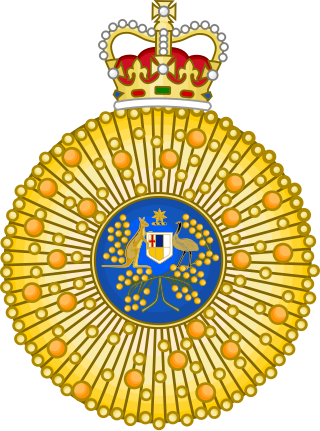
The Order of Australia is an honour that recognises Australian citizens and other persons for outstanding achievement and service. It was established on 14 February 1975 by Elizabeth II, Queen of Australia, on the advice of the Australian Government. Before the establishment of the order, Australian citizens received British honours.
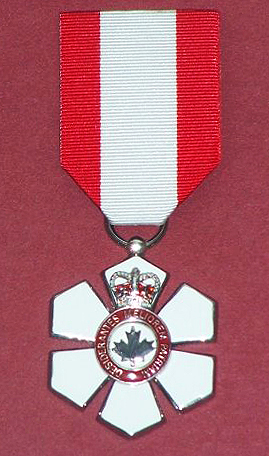
The Order of Canada is a Canadian state order and the second-highest honour for merit in the system of orders, decorations, and medals of Canada, after the Order of Merit.

Ramon John Hnatyshyn was a Canadian lawyer and statesman who served as governor general of Canada, the 24th since Canadian Confederation.
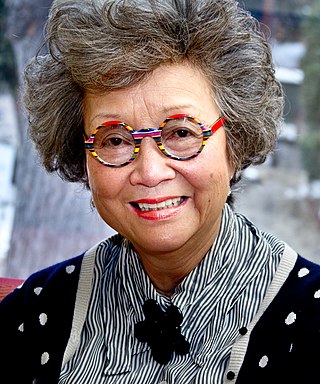
Adrienne Louise Clarkson is a Hong Kong–born Canadian journalist and stateswoman who served from 1999 to 2005 as Governor General of Canada, the 26th since Canadian Confederation.

Roméo-Adrien LeBlanc was a Canadian journalist and politician who served as Governor General of Canada from 1995 to 1999, the 25th since Canadian Confederation.

Joseph Jules Léger was a Canadian diplomat and statesman who served as Governor General of Canada, the 21st since Canadian Confederation.

Daniel Roland Michener was a Canadian lawyer, politician, and diplomat who served as Governor General of Canada, the 20th since Canadian Confederation.

The Most Honourable Order of the Bath is a British order of chivalry founded by King George I on 18 May 1725. The name derives from an elaborate medieval ceremony for preparing a candidate to receive his knighthood, of which ritual bathing was an element. While not all knights went through such an elaborate ceremony, knights so created were known as 'knights of the Bath', and likely from the upper classes to begin with. George I constituted the Knights of the Bath as a regular 'Military Order'. He did not revive the Order, which did not previously exist, in the sense of a body of knights governed by a set of statutes and whose numbers were replenished when vacancies occurred.

The Order of New Zealand is the highest honour in the New Zealand royal honours system, created "to recognise outstanding service to the Crown and people of New Zealand in a civil or military capacity". It was instituted by royal warrant on 6 February 1987. The order is modelled on the British Order of Merit and the Order of the Companions of Honour.

The Order of Ontario is the most prestigious official honour in the Canadian province of Ontario. Instituted in 1986 by Lieutenant Governor Lincoln Alexander, on the advice of the Cabinet under Premier David Peterson, the civilian order is administered by the Lieutenant Governor-in-Council and is intended to honour current or former Ontario residents for conspicuous achievements in any field.

The Royal Victorian Order is a dynastic order of knighthood established in 1896 by Queen Victoria. It recognises distinguished personal service to the monarch, members of the royal family, or to any viceroy or senior representative of the monarch. The present monarch, King Charles III, is the sovereign of the order. The order's motto is Victoria. The order's official day is 20 June. The order's chapel is the Savoy Chapel in London.

Michaëlle Jean is a Canadian stateswoman and former journalist who served from 2005 to 2010 as governor general of Canada, the 27th since Canadian Confederation. She is the first Haitian Canadian and black person to hold this office.

The Queen's Service Order, established by royal warrant of Queen Elizabeth II on 13 March 1975, is used to recognise "valuable voluntary service to the community or meritorious and faithful services to the Crown or similar services within the public sector, whether in elected or appointed office". This order was created after a review of New Zealand's honours system in 1974. The Queen's Service Order replaced the Imperial Service Order in New Zealand.
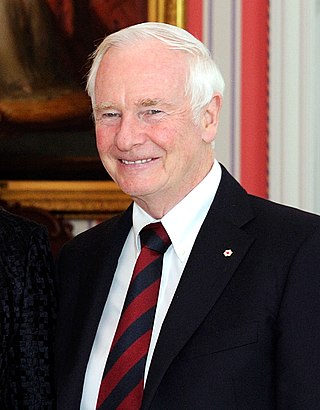
David Lloyd Johnston is a Canadian academic, author, and statesman who served from 2010 to 2017 as Governor General of Canada, the 28th since Canadian Confederation. Johnston was the special rapporteur appointed to investigate reports of foreign interference in recent Canadian federal elections until his resignation on June 9, 2023.
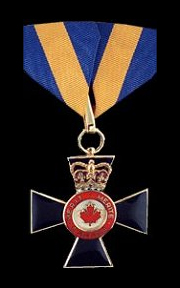
The Order of Merit of the Police Forces is an honour for merit that is, within the Canadian system of honours, the only such fellowship reserved for only members of Canada's various police forces. Created in 2000, the order is administered by the Governor in Council, on behalf of the Canadian monarch. Appointment to the order recognizes conspicuous merit and exceptional service, the level of which is reflected by the organization's three hierarchical grades.
The orders, decorations, and medals of Canada comprise a complex system by which Canadians are honoured by the country's sovereign for actions or deeds that benefit their community or the country at large. Modelled on its British predecessor, the structure originated in the 1930s, but began to come to full fruition at the time of Canada's centennial in 1967, with the establishment of the Order of Canada, and has since grown in both size and scope to include dynastic and national orders, state, civil, and military decorations; and various campaign medals. The monarch in right of each Canadian province also issues distinct orders and medals to honour residents for work performed in just their province. The provincial honours, as with some of their national counterparts, grant the use of post-nominal letters and or supporters and other devices to be used on personal coats of arms.
Appointees to the Order of Canada can have their membership revoked if the order's advisory council determines a member's actions have brought dishonour to the order. Eight people have been removed from the Order of Canada: Alan Eagleson, David Ahenakew, T. Sher Singh, Steve Fonyo, Garth Drabinsky, Conrad Black, Ranjit Chandra, and Johnny Issaluk. Eagleson was removed from the order after being jailed for fraud in 1998; Ahenakew was removed in 2005, after being convicted of promoting anti-Semitic hatred in 2002; Singh was removed after the revocation of his law licence for professional misconduct; Fonyo was removed due to numerous criminal convictions; Drabinsky was removed in 2012 after being found guilty of fraud and forgery in Ontario; Black was removed in 2014 after being convicted of fraud and obstruction of justice in the United States; Chandra was removed in 2015 for committing research fraud; Issaluk was removed in 2022 following sexual misconduct allegations. The formal removal process is performed by the Advisory Council of the Order of Canada, though it can be initiated by any citizen of Canada.

The Order of Military Merit is a military honour for merit that is, within the Canadian system of honours, the second highest order administered by the governor in Council on behalf of the Canadian monarch.
Five honorary appointments to the Order of Canada are permitted per year by the order's constitution. The following is a list of all honorary appointments to date. Names rendered in italics were later made Canadian citizens; these memberships thereby became regarded no longer as honorary but instead as substantive.

















